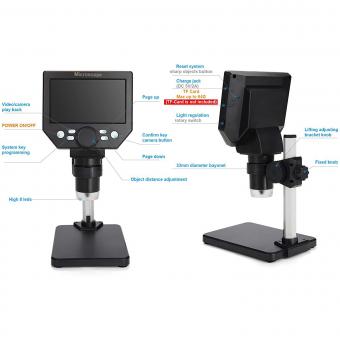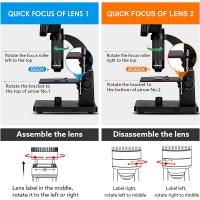How Does A Laser Scanning Confocal Microscope Work ?
A laser scanning confocal microscope works by using a laser beam to illuminate a sample and then collecting the emitted light through a pinhole aperture. The laser beam is focused onto a specific point on the sample, and the emitted light is detected by a photomultiplier tube or a detector array. The pinhole aperture allows only the light from the focal plane to pass through, while blocking out-of-focus light.
By scanning the laser beam across the sample in a raster pattern, a series of optical sections are obtained at different depths. These sections are then combined to create a three-dimensional image of the sample. The confocal microscope provides high-resolution images with improved contrast and reduced background noise compared to conventional microscopes. It is widely used in various fields of research, including biology, medicine, and materials science, for studying the structure and function of biological samples and other materials at the cellular and subcellular levels.
1、 Principle of laser scanning confocal microscopy
The principle of laser scanning confocal microscopy involves the use of a laser beam to illuminate a sample and a pinhole aperture to eliminate out-of-focus light. This technique allows for the acquisition of high-resolution, three-dimensional images of biological samples.
In a laser scanning confocal microscope, a laser beam is focused onto a specific point on the sample. The laser light is then reflected off the sample and collected by a detector. The detector measures the intensity of the reflected light, which is used to generate an image of the sample.
The key component of a confocal microscope is the pinhole aperture. This aperture is placed in front of the detector and blocks out-of-focus light from reaching the detector. By eliminating this out-of-focus light, the confocal microscope can produce images with improved contrast and resolution compared to conventional microscopes.
To generate a three-dimensional image, the laser beam is scanned across the sample in a raster pattern. The reflected light is collected at each point and used to build up a two-dimensional image. By scanning the laser beam through multiple planes, a stack of images is acquired, which can be reconstructed into a three-dimensional image of the sample.
The latest advancements in laser scanning confocal microscopy include the use of multiple lasers with different wavelengths to excite different fluorophores simultaneously. This allows for the visualization of multiple cellular components or molecules within a sample. Additionally, confocal microscopes can now be equipped with advanced imaging techniques such as fluorescence lifetime imaging or fluorescence correlation spectroscopy, which provide further insights into the dynamics and interactions of biological molecules.
Overall, laser scanning confocal microscopy provides a powerful tool for studying biological samples with high resolution and three-dimensional imaging capabilities. Its ability to eliminate out-of-focus light and its compatibility with various imaging techniques make it an essential tool in modern biological research.

2、 Optical components in laser scanning confocal microscopy
A laser scanning confocal microscope (LSCM) is an advanced imaging technique that provides high-resolution, three-dimensional images of biological samples. It works by using a laser beam to scan the sample and a confocal pinhole to eliminate out-of-focus light, resulting in improved image quality and optical sectioning.
The basic principle of an LSCM involves several optical components. Firstly, a laser is used as the light source, typically a high-intensity, monochromatic laser such as a helium-neon or argon-ion laser. The laser emits a focused beam of light that is directed onto the sample.
Next, a set of scanning mirrors is used to move the laser beam across the sample in a raster pattern. These mirrors can rapidly scan the laser beam in both the x and y directions, allowing for precise control over the scanning process.
As the laser beam interacts with the sample, it excites fluorescent molecules present in the sample. These molecules emit light at a longer wavelength, which is then collected by a detector. The emitted light passes through a confocal pinhole, which is placed in front of the detector. The pinhole acts as a spatial filter, allowing only the light emitted from the focal plane to pass through while blocking out-of-focus light.
The detector collects the emitted light and converts it into an electrical signal, which is then processed and used to generate an image. The scanning mirrors, confocal pinhole, and detector are all synchronized to ensure that only light from the focal plane is detected, resulting in a sharp, high-resolution image.
Recent advancements in LSCM technology have focused on improving imaging speed and sensitivity. For example, the use of resonant scanning mirrors allows for faster scanning rates, enabling real-time imaging of dynamic processes. Additionally, the development of highly sensitive detectors and advanced image processing algorithms has further enhanced the capabilities of LSCMs.
In conclusion, a laser scanning confocal microscope works by using a laser beam to scan a sample and a confocal pinhole to eliminate out-of-focus light. This technique provides high-resolution, three-dimensional images of biological samples and has seen significant advancements in recent years.

3、 Scanning mechanism in laser scanning confocal microscopy
A laser scanning confocal microscope (LSCM) is an advanced imaging technique that allows for high-resolution, three-dimensional imaging of biological samples. It works by using a laser beam to scan the sample and collect fluorescence signals, which are then used to construct an image.
The scanning mechanism in LSCM is a key component that enables the microscope to capture images with high spatial resolution. The laser beam is focused onto a small spot on the sample, and the spot is then scanned across the sample in a raster pattern. This scanning is typically achieved using a pair of galvanometer mirrors that rapidly move the laser beam in the x and y directions.
As the laser beam scans across the sample, it excites fluorescent molecules within the sample. These molecules emit light at a longer wavelength, which is then collected by a detector. However, to ensure that only light from the focal plane is detected, a pinhole aperture is placed in front of the detector. This pinhole blocks out-of-focus light, resulting in improved image contrast and resolution.
The collected fluorescence signals are then processed and used to construct an image of the sample. The scanning mechanism allows for the acquisition of multiple optical sections at different depths within the sample, which can be used to generate a three-dimensional image.
In recent years, there have been advancements in LSCM technology. For example, the use of resonant scanners has allowed for faster scanning speeds, enabling real-time imaging of dynamic processes. Additionally, the development of adaptive optics has improved the resolution and image quality by correcting for aberrations in the optical system.
Overall, the scanning mechanism in laser scanning confocal microscopy plays a crucial role in capturing high-resolution images of biological samples. The continuous advancements in technology continue to enhance the capabilities of LSCM, making it an invaluable tool in biological research.

4、 Image formation in laser scanning confocal microscopy
A laser scanning confocal microscope (LSCM) is an advanced imaging technique that allows for high-resolution, three-dimensional imaging of biological samples. It works by using a laser beam to scan the sample point by point and then detecting the emitted light from each point.
The basic principle of LSCM involves focusing a laser beam onto a specific point on the sample. The laser light excites fluorophores in the sample, causing them to emit fluorescent light. However, instead of collecting all the emitted light, LSCM uses a pinhole aperture to block out-of-focus light. This pinhole is placed in front of a detector, which only detects the light that is in focus. By scanning the laser beam across the sample and detecting the emitted light at each point, a high-resolution image is formed.
The pinhole aperture in LSCM is a crucial component as it eliminates the out-of-focus light, resulting in improved image contrast and resolution. This technique, known as optical sectioning, allows for the visualization of thin optical sections of the sample, which can be reconstructed into a three-dimensional image.
In recent years, there have been advancements in LSCM technology. For example, the use of multiple lasers with different wavelengths allows for the simultaneous imaging of multiple fluorophores, enabling the study of multiple cellular components or processes in a single experiment. Additionally, the development of faster scanning systems and sensitive detectors has improved the speed and sensitivity of LSCM, making it more suitable for live-cell imaging.
Overall, LSCM is a powerful imaging technique that provides high-resolution, three-dimensional images of biological samples. Its ability to eliminate out-of-focus light and its compatibility with various fluorophores make it an essential tool in biological research and medical diagnostics.





































